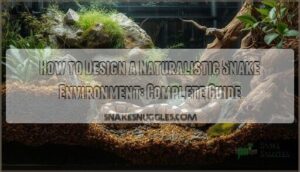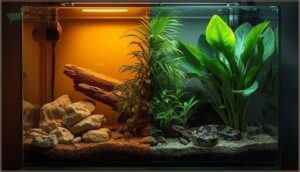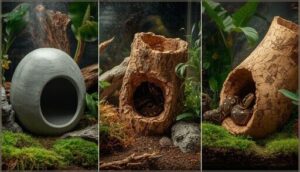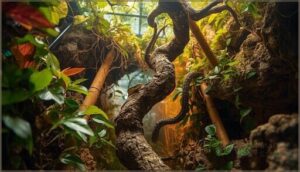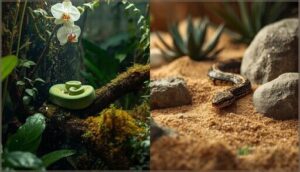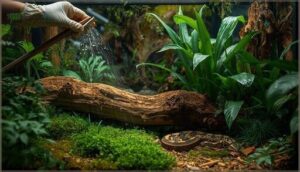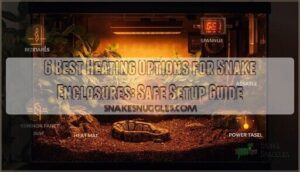This site is supported by our readers. We may earn a commission, at no cost to you, if you purchase through links.
Snake enclosures often fail their inhabitants more than keepers realize—45.9% more escape attempts occur when an enclosure falls even slightly short of the snake’s full body length. That single dimension sends a biological distress signal that reverberates through every aspect of your snake’s health, from cortisol levels to feeding response.
The difference between a container that holds a snake and a habitat that sustains one lies in understanding how environmental design shapes behavior at the neurological level. You’re not decorating a terrarium; you’re architecting a microecosystem where temperature gradients, substrate composition, and spatial security work as interconnected variables.
Getting these elements right transforms captive care from mere survival to genuine thriving, where your snake exhibits the full repertoire of natural behaviors evolution hardwired into its brain.
Table Of Contents
- Key Takeaways
- Choosing The Best Enclosure for Snakes
- Selecting Naturalistic Substrate Materials
- Creating Temperature and Humidity Gradients
- Incorporating Natural Hiding Spots
- Adding Water Features and Drinking Areas
- Integrating Climbing and Enrichment Elements
- Replicating Species-Specific Habitat Needs
- Maintaining a Healthy Snake Environment
- Frequently Asked Questions (FAQs)
- Conclusion
Key Takeaways
- Enclosures must match or exceed your snake’s full body length—anything shorter triggers 45.9% more escape attempts and measurable stress responses that compromise immune function and feeding behavior.
- Temperature gradients aren’t aesthetic choices but survival requirements: you need thermal zones spanning 88–92°F at basking spots down to 75–82°F at cool ends, allowing your snake to self-regulate digestion, metabolism, and immune response.
- Species-specific substrate depth matters more than material alone—arboreal snakes need 60-80% humidity control with coconut chips, terrestrial species require 2-3 inches of aspen or soil, and burrowing snakes demand 4-6 inches for natural tunneling behaviors.
- Environmental enrichment through hiding spots, climbing structures, and rotated features isn’t decoration but neurological necessity—enriched habitats boost exploration by 8%, reduce stress hormones by 23%, and increase resting time by 35% compared to bare enclosures.
Choosing The Best Enclosure for Snakes
Your enclosure is the foundation of everything—it’s where your snake will spend its entire life, so getting this right matters more than you might think. The wrong choice can lead to stress, escape attempts, or even health problems down the line.
Let’s break down the key factors you need to examine: size requirements, material options, and the security features that keep your snake safe and contained.
Size and Space Requirements
Your snake’s enclosure dimensions must meet science-backed minimums: at least equal to your snake’s full body length. This isn’t negotiable—enclosures shorter than snake length show 45.9% more escape attempts and significant health problems.
Calculate space using the 0.7 x 0.5 formula for floor area, adjusting habitat volume as your snake grows. Think rectilinear movement, not confinement.
Ensuring proper snake care involves understanding snake welfare standards to create a healthy environment.
Glass Vs. Plastic Vs. DIY Options
You’ve picked your size—now choose your enclosure material. Glass terrariums dominate the reptile enclosure market with unrivaled visibility and climate control, but they’re heavy and heat-hungry.
Plastic (especially PVC) retains heat and humidity better, weighs less, and offers excellent customization options for your vivarium setup.
DIY wood enclosures deliver maximum flexibility in naturalistic setup design, though they demand careful sealing against moisture damage.
When selecting materials, consider the benefits of reptile enclosure options to create an ideal environment.
Security and Ventilation Features
Material choice means nothing if your reptile enclosure leaks snakes. Nearly 70% of escapes happen because of lid failures—your enclosure security demands attention:
- Wire locks on sliding doors stop persistent escape artists cold
- Solid grommets eliminate mesh gaps small snakes exploit
- 3-5 air changes per hour maintain respiratory health without drafts
- Vent placement balances airflow management with stable temperatures
- Double-door setups with locking mechanisms achieve zero escapes
Proper ventilation systems prevent respiratory disease while secure lids protect your investment in habitat creation.
Selecting Naturalistic Substrate Materials
The substrate you choose becomes the foundation of your snake’s entire world, so picking the right material matters more than most keepers realize. Different species have wildly different needs—what works for a burrowing hognose won’t cut it for an arboreal tree python.
Let’s break down the substrate options that’ll keep your snake comfortable, healthy, and thriving in a naturalistic setup.
Substrate Options for Different Species
Your substrate choices can make or break your snake habitat. Arboreal species thrive on coconut chips or sphagnum moss with 60-80% humidity control, while terrestrial snakes need aspen bedding or soil mixes at 2-3 inches depth. Burrowing materials like sandy soil require 3-5 inches for hognose snakes to tunnel properly. Match substrate depth and moisture levels to your species-specific needs.
Benefits of Natural Substrates
Choosing naturalistic habitat materials transforms your terrarium setup from a sterile cage to a thriving ecosystem. Natural substrates deliver advantages synthetic options can’t match:
- Humidity control through substrate moisture retention keeps relative humidity stable at 65-75%, fostering healthy shedding cycles without constant misting
- Thermal buffering moderates temperature swings, creating the microclimatic zones your snake needs for proper thermoregulation
- Habitat enrichment through varied textures triggers natural behaviors like burrowing and exploration, while microbial balance promotes overall wellness
Cleaning and Maintenance Considerations
Maintenance demands vary dramatically based on substrate choice and enclosure design. Consistent sanitation protocols are essential to prevent bacterial buildup, while also balancing maintenance costs against your snake’s welfare.
| Cleaning Schedules | Disinfection Methods | Waste Management |
|---|---|---|
| Daily spot cleaning removes feces and shed skin | Reptile-safe disinfectants like F10 or chlorhexidine (1:30 dilution) kill pathogens | Immediate removal prevents contamination spread |
| Weekly inspection checks for mold and debris | Steam cleaning offers chemical-free sanitation above 200°F | Bioactive setups use microfauna to decompose waste naturally |
| Deep cleaning every 4-6 weeks replaces all substrate | Hypochlorous acid safely mists surfaces and plants | Vacuum or scoop soiled bedding with surrounding material |
| Frequency adjusts based on species waste output and enclosure size | Heat-based methods sterilize equipment without toxicity | Proper protocols reduce pathogen transmission in multi-snake collections |
Natural substrates require more attentive habitat maintenance than paper products, but they support reptile health through enrichment and humidity control—making the extra effort worthwhile for serious reptile care enthusiasts.
Creating Temperature and Humidity Gradients
Your snake can’t regulate its own body temperature—it depends entirely on you to create the right environment. Without proper thermal and humidity gradients, even the healthiest snake will struggle with digestion, shedding, and immune function.
Your snake depends entirely on you to create the thermal and humidity gradients it needs to survive and thrive
Let’s break down how to set up these critical gradients so your snake can thermoregulate naturally and thrive.
Setting Up Thermal Zones
Think of your snake’s enclosure design like a thermal landscape—you’re crafting a living map of temperature zones.
Install heat sources covering roughly one-third of the floor, creating thermal gradients from 88–92°F at the basking spot down to 75–82°F at the cool end. Position digital thermometers in each zone and use thermostats to prevent overheating.
This temperature gradient supports your snake’s natural temperature regulation instincts.
Humidity Control Techniques
You control your snake’s humidity through strategic layers—mist spraying, humidifier use, fogger systems, and substrate moisture work together to build stable humidity zones. Daily misting spikes humidity by 10-20%, while automated foggers maintain consistent humidity levels for 12+ hours.
Position water bowls near heat sources to boost environmental control through evaporation, and use hygrometer calibration to verify your temperature and humidity control stays within species-specific ranges.
Monitoring Tools and Devices
Your environmental monitoring arsenal transforms guesswork into precision—IoT devices sample conditions every 1–4 seconds, logging trends you access from anywhere via smartphone apps.
- Dual-sensor monitors track temperature gradient and humidity levels simultaneously with ±0.5°C accuracy
- Smart alarms send SMS alerts within 10 seconds of threshold breaches
- Zone-specific sensors support multi-area environmental control in larger enclosures
- Data analytics platforms archive 365 days of ecosystem balance metrics
- AI-enabled behavioral tracking correlates environmental monitoring with stress patterns for proactive temperature regulation adjustments
Incorporating Natural Hiding Spots
Your snake won’t thrive in the open—hiding spots aren’t optional, they’re essential for reducing stress and helping your snake feel secure.
You can choose from commercial hides, build your own, or use natural materials like cork bark and logs to mimic what they’d find in the wild. Let’s break down your options and how to position them for maximum security.
Types of Hides (Commercial, DIY, Natural)
You’ll encounter three main hide categories when building your snake habitat. Commercial options, like ceramic hides and PVC shelters, offer excellent material durability and hide maintenance ease.
DIY materials, such as paper clay, let you craft custom naturalistic habitat features with natural textures.
Authentic hiding spots, like cork bark or coconut shells, provide distinctive habitat enrichment while controlling humidity in your enclosure.
Placement Strategies for Security
Once you’ve chosen your hides, position them strategically within your snake enclosure. Effective hide placement means creating dual zones—placing hides on both warm and cool sides of your outdoor snake habitat allows natural thermoregulation.
Corner hides near walls provide maximum security, reducing escape attempts by 41%. Secure mounting prevents collapses, while visual barriers like foliage between hides boost movement confidence by 48%.
Importance for Stress Reduction
Beyond strategic placement, hiding spots serve as your primary stress management tool in habitat design. Research shows snakes with species-appropriate naturalistic habitat features spend 35% more time resting, while enriched environmental conditions reduce stress hormones by 23%.
These environmental enrichment elements aren’t decorative—they’re foundational to animal welfare, directly improving snake behavior and overall health through measurable stress reduction.
Adding Water Features and Drinking Areas
Water isn’t just about hydration—it’s a critical tool your snake uses to regulate body temperature, aid in shedding, and maintain overall health. You’ll need to think beyond a simple bowl and consider depth, accessibility, and cleanliness to meet your snake’s specific needs.
Let’s break down how to design water features that truly support your snake’s natural behaviors.
Designing Safe Water Bowls and Pools
When you’re choosing water features for your reptile enclosure, Bowl Stability matters—ceramic dishes reduce tipping by 80% compared to plastic. Water Depth should never exceed 1 inch above your snake’s resting height to prevent drowning. For Pool Safety, include textured sides or ramps so your snake can exit easily.
Proper habitat design ensures Snake Hydration while keeping your naturalistic habitat functional, and smart Sanitation Methods start with removable water dish options.
Maintaining Water Cleanliness
Water Quality demands daily spot checks and weekly deep cleans—your water dish becomes a bacteria breeding ground faster than you think.
Effective Cleaning Protocols mean scrubbing with reptile-safe disinfectants, then rinsing thoroughly.
For sophisticated habitat enrichment, Filtration Systems maintain ecosystem balance in larger water features, while proper Hygiene Management and Chemical Control prevent the pathogen buildup that undermines your reptile husbandry efforts.
Benefits of Water for Thermoregulation
Thermal Inertia transforms water features into powerful thermoregulatory tools within your snake habitat. When your snake immerses itself, water temperature creates stability that buffers against dangerous spikes—aquatic microhabitats reduce daily temperature fluctuations while supporting natural thermoregulatory behavior.
This matters because hydration needs directly influence temperature regulation: dehydrated snakes select cooler zones, compromising digestion. Strategic thermal gradients near water and proper humidity levels enable full-body thermoregulation that keeps your reptile thriving.
Integrating Climbing and Enrichment Elements
Your snake’s enclosure shouldn’t be a bare-bones box—it should spark curiosity and challenge their instincts. Adding vertical structures and interactive features transforms a static space into a vibrant habitat that keeps your snake engaged and healthy.
Let’s break down the essential elements that’ll turn your enclosure into an enriching environment.
Branches, Vines, and Shelves
Climbing structures transform your terrarium design from sterile box to naturalistic habitat. You’ll want cork bark, manzanita, or mopani branches—they resist mold in humid setups.
For vine installation, choose sturdy artificial vines that support your snake’s weight while mimicking rainforest canopies. Shelf design matters: secure multiple mounting points prevent dangerous falls.
Natural decor like driftwood provides hiding spots and habitat enrichment, encouraging your snake’s instinctive climbing behaviors.
Environmental Enrichment for Activity
Activity levels surge when you provide environmental stimulation that aligns with your snake’s natural instincts. Studies show enriched habitats boost exploration by nearly 8%, with snakes spending more time climbing and investigating their territory.
- Sensory engagement through varied textures and scents prevents habituation
- Hiding spots positioned strategically reduce stress while encouraging movement
- Feeding enrichment like hidden prey triggers natural foraging behaviors
- Physical fitness improves as snakes navigate complex three-dimensional spaces
Environmental enrichment isn’t optional—it’s essential for behavioral diversity and neurological development.
Rotating Features to Prevent Boredom
Novelty stimulation transforms routine habitats into vibrant ecosystems. Research confirms that feature rotation drives up to 30% higher activity levels while cutting stress behaviors by 40%.
Your rotation schedules should swap branches, hides, and substrate textures every one to two weeks to maintain environmental diversity. This enrichment strategy prevents habituation and sharpens cognitive function.
Systematic rotation of environmental enrichment elements delivers measurable improvements in snake behavior, feeding response, and overall habitat enrichment effectiveness.
Replicating Species-Specific Habitat Needs
You can’t just drop any snake into a generic setup and expect it to thrive. Each species evolved in a specific corner of the world, with unique behaviors and survival needs that your enclosure must honor.
Let’s break down how to research and replicate those environments so your snake doesn’t just survive—it flourishes.
Researching Native Environments
Understanding your snake’s native ecosystems isn’t optional—it’s the foundation for proper habitat research and species-specific needs. Temperature and humidity patterns drive species distribution across diverse environments, from the Cerrado’s 222 documented species to Atlantic Forest domains. To replicate natural habitat accurately:
- Study your species’ geographic origin and microhabitat preferences
- Examine environmental factors like seasonal rainfall and temperature gradients
- Investigate ground-dwelling versus arboreal behaviors in native ecosystems
- Consider biodiversity conservation data for ecosystem balance insights
Tailoring for Arboreal, Terrestrial, or Burrowing Snakes
Your snake’s lifestyle dictates habitat lighting, spatial priorities, and substrate choices. Arboreal species demand vertical space with climbing structures up to 2 feet cube enclosures, while terrestrial snakes need horizontal floor space matching their body length. Burrowing species require 4-6 inches substrate depth for natural digging.
Species research guides reptile enclosure design: prioritize height for climbers, ground-level hiding spots for terrestrial snakes, and deep substrate for burrowers to meet species-specific needs and support natural snake behavior.
Addressing Special Behavioral Requirements
Beyond basic spatial needs, some snakes demand behavioral adaptation through targeted environmental enrichment. Species research reveals unique requirements: emerald tree boas need multiple perching levels for hunting postures, while hognose snakes require loose substrate for dramatic defensive displays.
Habitat customization addressing these species-specific care nuances—from cognitive puzzles to specialized climbing angles—drives stress reduction and fosters natural snake behavior and psychology that standard setups miss entirely.
Maintaining a Healthy Snake Environment
Your work doesn’t end once you’ve built the perfect enclosure—keeping it that way is where the real commitment begins. A naturalistic setup demands consistent attention to cleanliness, careful observation of your snake’s behavior, and the flexibility to make changes when something isn’t working.
Let’s break down the essential maintenance practices that’ll keep your snake thriving in its carefully crafted environment.
Routine Cleaning and Sanitation
Consistently implementing proper Sanitation Methods transforms your Snake Habitat Design from a disease incubator into a thriving sanctuary. Daily spot cleaning removes waste within minutes, while weekly protocols target high-traffic zones with reptile-safe disinfectants like chlorhexidine.
Monthly deep Cleaning Schedules demand full substrate replacement and thorough Disinfectant Use—always rinse completely.
These Hygiene Practices directly impact reptile health and wellness, making routine Waste Management non-negotiable for serious Reptile Care and Maintenance.
Monitoring Snake Health and Behavior
Once your enclosure gleams from proper sanitation, you’ll need sharp observational skills to catch what sanitizers can’t fix. Snake Health Checks demand daily scrutiny—watch for active tongue flicking, consistent feeding responses, and smooth movement patterns that signal wellness.
Key behavioral indicators you can’t afford to miss:
- Tongue activity reveals scent sampling and environmental awareness
- Feeding behavior changes flag illness before physical symptoms appear
- Movement frequency below 18% daily suggests lethargy or stress
- Shedding quality directly reflects hydration and overall health
Behavioral Analysis paired with Environmental Monitoring through digital thermometers and humidity sensors creates your early warning system. Health Tracking Tools like thermal imaging cameras detect activity patterns invisible to the naked eye, while regular weight measurements expose muscle wasting before it becomes critical. These Stress Reduction Techniques—combining hands-off tech with targeted physical exams—protect both snake health and species conservation efforts by catching problems when they’re still fixable.
Adjusting Habitat Based on Observations
Your careful health observations reveal something powerful: patterns that demand action. Habitat Monitoring through Observation Techniques shows when your snake repeatedly avoids basking areas—you’ll need to adjust temperature regulation zones.
Environmental Adaptation becomes your toolkit when behavioral data signals unmet species-specific needs. Adaptive Design means rotating habitat enrichment elements based on actual usage patterns, creating a responsive ecosystem design that evolves with your snake’s preferences rather than fighting them.
Frequently Asked Questions (FAQs)
Can live plants be safely used in snake enclosures?
When the rubber meets the road, yes—live plants work beautifully in snake habitats, boosting enclosure hygiene and habitat enrichment.
Just avoid plant toxicity issues like philodendrons, prioritize snake safety, and maintain proper terrarium setup with substrate choices supporting plant maintenance.
How do seasonal changes affect indoor snake habitats?
Seasonal changes create temperature fluctuations and humidity control challenges indoors, triggering shifts in snake behavior through environmental cues.
You’ll need to adjust heating, moisture levels, and substrate choices to support proper temperature regulation year-round.
How often should habitat decorations be replaced or rotated?
You’ll want to deep clean decorative elements every 2-4 months, though spot cleaning weekly keeps bacteria at bay.
Rotate substrate choices and terrarium setup features every 3-4 weeks for snake enrichment—balancing habitat refresh with stability prevents stress while supporting environmental enrichment and stimulation.
Do snakes benefit from background noise or music?
Snakes don’t benefit from background noise or music. They lack auditory stimulation needs like mammals. Instead, loud sounds cause stress through vibrational responses.
Maintain quiet environments to support natural animal behavior and reduce noise pollution impacts.
Conclusion
Snakes that thermoregulate properly live 40% longer in captivity—proof that designing a naturalistic snake environment isn’t cosmetic, it’s clinical.
Every substrate choice, every thermal gradient, every hide placement becomes a variable in your snake’s physiological equation. You’re not arranging decorations; you’re calibrating the environmental triggers that determine whether stress hormones flood your animal’s system or natural behaviors flourish.
The enclosure doesn’t just contain your snake—it programs its biology.
- https://waynehighlands.com/category/natural-world/
- https://set.adelaide.edu.au/news/list/2021/07/02/snakes-need-to-stretch-scientists-say
- https://www.ufaw.org.uk/press-releases/study-identifies-potential-welfare-concerns-for-privately-kept-snakes
- https://ned.apes.org.uk/books/general-reptile-care-and-rules/page/uk-guide-to-reptile-enclosure-sizes-general-rules-metrics-and-species-specific-recommendations
- https://responsiblereptilekeeping.org/cliffords-diadem-snake-husbandary-details/enclosure-size

